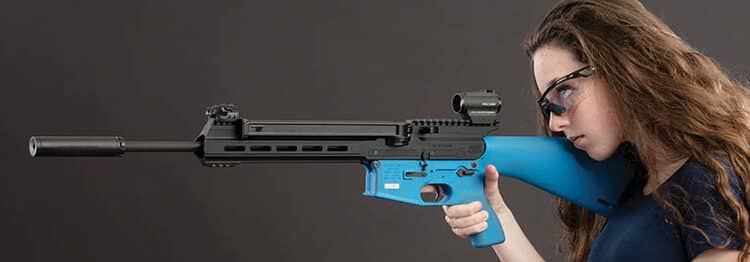By Oleg Volk
Introduced around 2010, the AR57 blowback upper receiver for the AR15 uses 50-shot P90 magazines and ejects spent casings down through the magazine well for ambidextrous operation. Operating by simple blowback, this upper is available in 6-inch pistol and 16-inch rifle versions. Chambered in 5.7x28mm, this upper is less powerful than the standard 5.56mm version, but that reduction in power brings certain advantages: reduced muzzle blast, a high practical rate of fire, nonexistent recoil, lightness even when fully loaded and, thanks to the top-mounted magazine, the opportunity for the shooter to get very low to the ground for cover. The upper arrives with a custom buffer that fits any carbine AR15 lower.
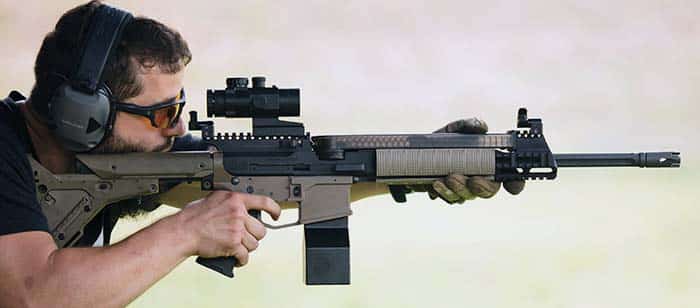
The first generation came with a medium-weight fluted barrel and full Picatinny rail, which made the potentially light personal defense weapon into more of a varmint rifle. Unfortunately, the intrinsic accuracy of the cartridge yielded mediocre results for tagging small varmints. Of all available ammunition, RRWS copper hollow-point seems to offer the best combination of accuracy (2MOA) and terminal performance (2/3-inch expansion from the original 0.224-inch diameter and around 15 inches of penetration in gel after four layers of denim). Velocity was around 2680 feet per second with SD under 10, so it was no surprise that this cartridge produced more accurate results than other factory loads.
- American Eagle FMJ 40gr 2020fps 3MOA
- RRWS HP 37gr 2680fps (substantially higher than advertise 2550fps) 2MOA
- FN Vmax 40gr 2600fps 2.5MOA
- Handloads Vmax 40gr 2175fps 2MOA
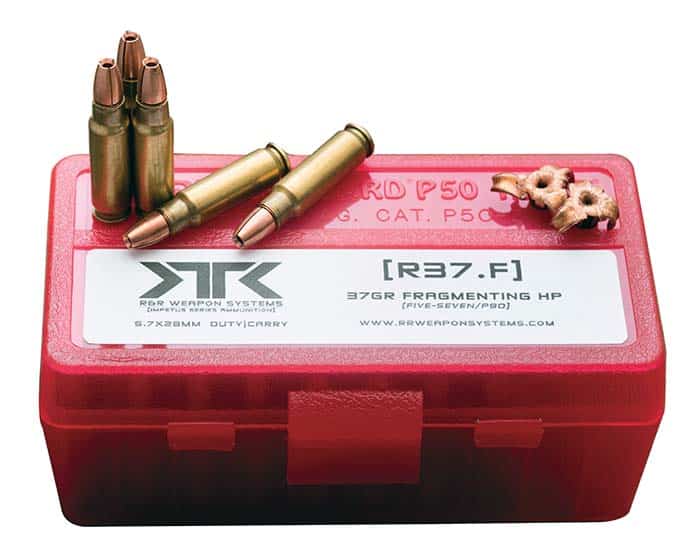
The second generation cut quite a bit of weight by going to a light profile barrel and M-LOK forend with only small rail segments machined in it top and bottom of the front—ideal for a backup front sight and a bipod. Unloaded, but with a Holosun red dot sight, the 2nd Gen. AR57 on a GWACS Armory polymer lower weighs only 5.3 pounds. Fully loaded, it remains a reasonable 6.7 pounds, light enough for most shooters. Placed on an aluminum lower, it gets slightly heftier but gains length of pull adjustment and more neutral balance.
While the reduction in barrel diameter cuts heat endurance, the cartridge used makes this a mostly theoretical issue. Burning around six grains per shot, 5.7x28mm runs much cooler than 5.56mm, which burns four or more times as much. That yields much reduced muzzle blast and far greater heat endurance, though this is naturally at the cost of bullets traveling roughly 40% slower. Even the thin barrel has continuous fire endurance in excess of 150 shots, plenty for any realistic defensive fight. The real limiter of the sustained fire is the exposure of the plastic top-mounted magazine to the heat radiating from the barrel.
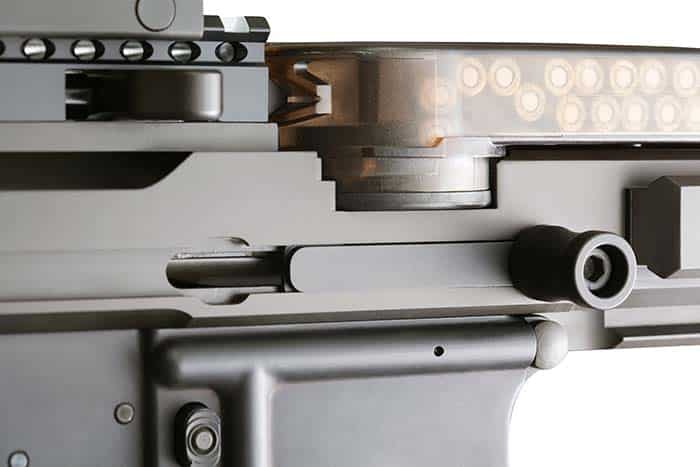
To load, place the baseplate of a standard FN P90 magazine into the recess on the front of the upper, then press the feed lip side down on the catch located above and slightly back of the bolt. To charge, pull on the right-side non-reciprocating handle and release. The charging handle’s placement on the right makes it accessible for operation by the strong hand. Since it only has to be operated once every 50 shots, the time penalty for moving the hand off the pistol grip isn’t too great. Empties will eject downward through the nominal magazine well. Some users put a 20- or 30-round magazine body with the feed lips, spring and follower removed to act as a brass catcher. AR15sport.com offers a sheet metal brass catcher of much greater capacity. We tested it on two AR57s at a high round count event with good results. The magazine has no provision for activating the bolt lock when empty, but the bolt can be locked open using the catch on the lower. The upper runs very cleanly and reliably, requiring no maintenance after the first 500 shots.
At $745 from 57center.com, it is less expensive than a PS90 carbine at $1,350, even after the cost of an AR15 lower is added in. 5.7x28mm ammunition costs about as much as 5.56x45mm, though the variety of available loads is definitely smaller.
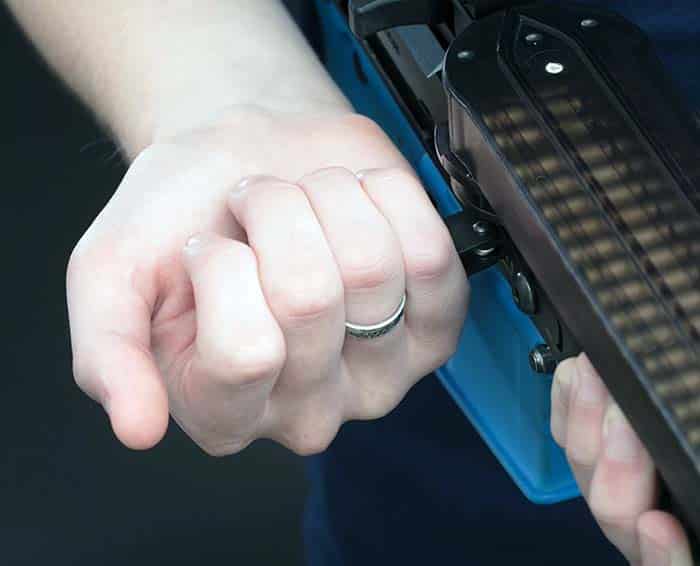
The adequacy of 5.7x28mm for stopping human aggressors has been in dispute ever since its introduction. Some of the lighter bullets available for it have traditionally been tipped or leadless hollow-points prone to excessive fragmentation. Firing a 27gr lead-free hollow-point at a full, upright 12-ounce beverage can did not result in complete penetration—an excellent result for a range or a small varmint round, but not a man-stopper. Expanding ammunition with better penetration is also available from FN, along with non-fragmenting 40gr FMJ American Eagle. R&R Weapon Systems offers two 37gr all-copper loads, 37F (fragmenting) and 37X (expanding). I would recommend 37X for defensive use, relegating the fragmenting load to short-range varmint elimination.
The main limitation in using the AR57 for varmint control is the space available for optics. With the magazine lifting up for unloading, the length of the scope is sharply limited. I was able to fit 2.5x or 4x prismatic scopes, anything longer caused interference. Considering the sighting limitations, I would rate it as suitable for small rodents out to 100 yards. With defensive use being its more likely purpose, AR57 works best with a smaller red dot sight or an illuminated 1x prismatic scope like the Vortex Spitfire, since the speed of target acquisition trumps precision. Follow-up shots with the 2nd Gen. AR57 were limited only by trigger finger dexterity, as it showed no muzzle rise at all. The newer version moved a little more, as the fairly effective flash hider/compensator got replaced by a thinner, less effective variant that was also quite loud. My recommendation would be to install something like a Kaw Valley Precision linear compensator, which would leave the minimal muzzle rise uncorrected but noticeably reduce the report at the shooter’s ears. AR57 also works well with sound suppressors, producing no gas blowback and only a mild ejection port pop.
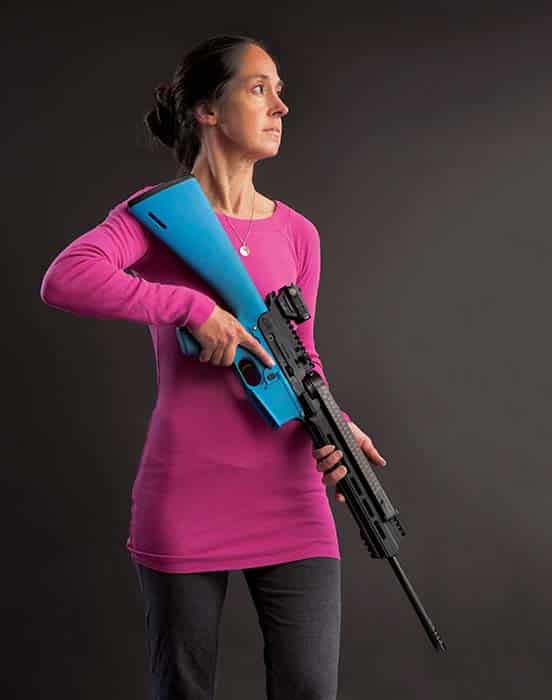
The new, lightweight AR57 is lighter than a PS90, though about 8 inches longer. The advantages of AR57 are numerous. Even a stock AR15 has a better trigger than PS90, and aftermarket options can make that difference extreme. AR lowers allow adjustable length of pull. AR ergonomics, excepting the reloading process, make more use of existing training. The height of sights over bore is significantly less, making accurate hits easier.
Compared to a 5.56 upper, AR57 is simpler to clean, generates less felt recoil and much less muzzle blast. With no protruding magazine, it allows the shooter to get into a very low prone position. A lot of ammunition can be carried, as two full 50-round P90 magazines weigh as little as one 5.56 30-rounder. The niche I see for AR57—besides it being plain fun to shoot—is for self-defense by the same slightly built individuals who would have picked an M1 carbine in the past. It requires less upper body strength to use than most long guns and gives 50 shots without reloading. A small teenager or a fragile senior can run it with ease, with the generously sized charging handle being on the side of the strong hand for most users. The rest of us enjoy shooting this upper without even looking for an excuse.
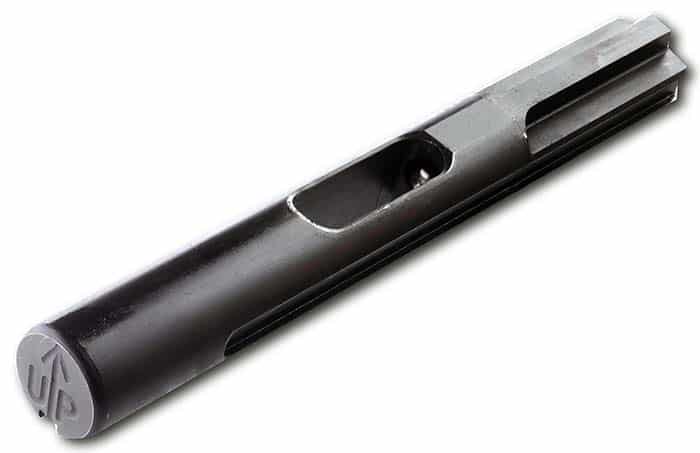
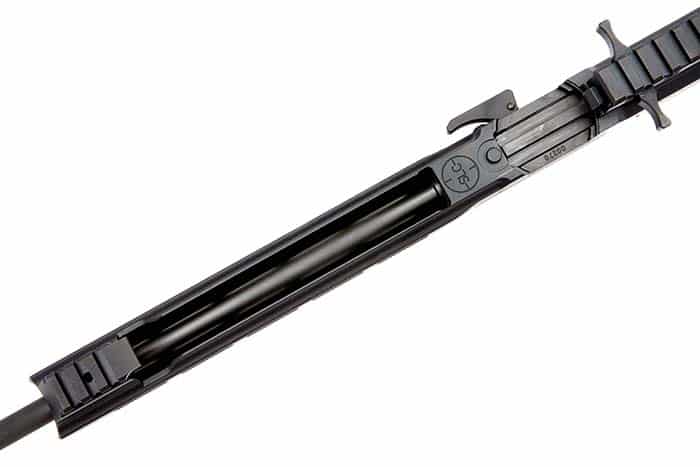
| This article first appeared in Small Arms Review V21N7 (September 2017) |



